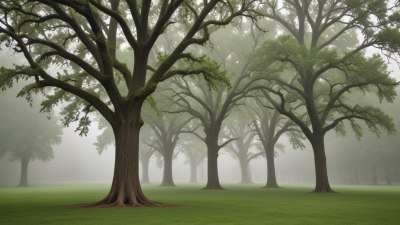The Role of Trees in Local Weather Patterns
Explore how trees influence local weather patterns and their ecological significance.

This image was created with the assistance of Freepik
Trees play a crucial role in shaping local weather patterns, influencing everything from temperature to precipitation. They act as living organisms that interact dynamically with the atmosphere, providing various benefits to the environment and human life. Understanding the role of trees in local weather is fundamental for conservation efforts, climate change discussions, and urban planning. This article delves deep into the various ways trees affect weather and climate, and the implications for local ecosystems.
1. The Basics of Tree Physiology
Trees are complex organisms composed of various parts that function together to maintain life. The leaves, trunk, roots, and overall structure of trees are vital in their interactions with the atmosphere. Through a process known as transpiration, trees release water vapor into the air. This release of moisture is essential for creating a humid microclimate, which can influence temperature and precipitation in the immediate vicinity.
2. Transpiration and Local Rainfall
Transpiration is the process by which water absorbed by plant roots is evaporated into the atmosphere through small openings in leaves called stomata. This water vapor forms clouds and can contribute to local rainfall. In densely vegetated areas, trees can enhance rainfall by increasing humidity and promoting precipitation. The water vapor released into the air helps to cool the environment and can lead to increased cloud formation, thereby influencing local weather patterns.
3. Heat Regulation and Urban Heat Islands
Trees also play a significant role in regulating temperature. They provide shade, which can lower surface temperatures, particularly in urban areas experiencing the urban heat island effect. This phenomenon occurs when urban areas heat significantly more than their rural surroundings due to human activities, buildings, and infrastructure. Trees help mitigate this effect by providing shade and cooling the air through evapotranspiration.
4. Wind Breaks and Storm Protection
The physical structure of trees serves as a natural barrier against winds. Tree lines can significantly reduce wind speed, which can help to protect crops and settlements from storm damage. In agricultural settings, rows of trees act as windbreaks, reducing soil erosion and protecting sensitive plants from strong winds. Additionally, deep-rooted trees help stabilize the soil, reducing the risk of landslides and further protecting local ecosystems.
5. Carbon Sequestration and Climate Change
One of the most critical roles of trees in the context of local weather patterns is carbon sequestration. Trees absorb carbon dioxide from the atmosphere, reducing greenhouse gases and helping to mitigate climate change. This not only influences global weather patterns but also has local implications. As trees store carbon, they contribute to improved air quality and can alter local climatic conditions by influencing temperature and humidity.
6. Biodiversity and Ecosystem Services
The presence of trees in an ecosystem enhances biodiversity by providing habitats for numerous species. This biodiversity is essential for resilient ecosystems, which can better withstand climate-related challenges. Trees not only provide food and shelter for wildlife but also play a key role in maintaining soil health and water cycles. Healthy ecosystems are better able to respond to changes in weather patterns and climate extremes.
7. The Impact of Deforestation
Deforestation and land-use change significantly disrupt local weather patterns. Removing trees alters the local microclimate, leading to increased temperatures, reduced rainfall, and increased vulnerability to natural disasters. The loss of trees reduces the ability of the land to retain moisture, resulting in drier conditions and impacting agriculture and local water supplies. Understanding these impacts is crucial for effective environmental policy and conservation strategies.
8. Community and Urban Forestry Initiatives
Community engagement in tree planting and maintenance projects is vital for sustaining urban ecosystems. Urban forestry initiatives aim to increase green spaces in cities, thereby enhancing the benefits trees provide for local weather regulation. These projects can involve local residents in the maintenance of trees, which fosters a sense of community while addressing climate-related issues. Creating green corridors in urban areas not only improves aesthetics but also helps mitigate urban heat island effects and improve air quality.
9. The Future of Trees and Weather Patterns
As climate change continues to affect global weather patterns, the role of trees in maintaining ecological balance becomes even more critical. Future conservation efforts will likely focus on preserving existing forests and restoring degraded areas to enhance their ability to regulate local climates. Research and policy development are essential to understanding how best to utilize trees in climate adaptation strategies. Innovative approaches, such as agroforestry and urban greening, are being explored to maximize the benefits trees provide.
In conclusion, trees are integral to local weather patterns, influencing temperature, humidity, and precipitation. Their various roles, from providing shade and reducing wind speed to sequestering carbon and supporting biodiversity, underscore their importance in maintaining ecological health. As we face growing challenges related to climate change, understanding and enhancing the role of trees in our local environments will be vital for future sustainability. Advocating for tree conservation and planting initiatives ensures that we protect and benefit from these essential components of our ecosystems.











